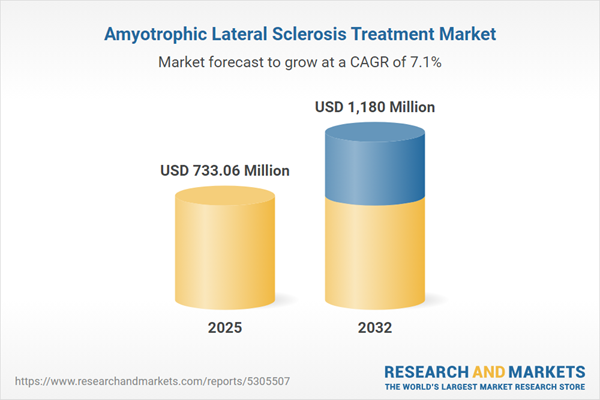Speak directly to the analyst to clarify any post sales queries you may have.
The amyotrophic lateral sclerosis treatment market is advancing rapidly, shaped by breakthroughs in therapeutic innovation, evolving patient needs, and ongoing shifts in global healthcare policy. Understanding these developments is essential for organizations seeking sustained growth and competitive positioning within this complex landscape.
Market Snapshot: Amyotrophic Lateral Sclerosis Treatment Market
The Amyotrophic Lateral Sclerosis (ALS) Treatment Market grew from USD 688.06 million in 2024 to USD 733.06 million in 2025. Continued momentum is projected with a CAGR of 7.07%, reaching USD 1.18 billion by 2032. These figures underline consistent expansion and growing strategic opportunities, driven by advances in treatment modalities, emerging technologies, and a shifting regulatory environment.
Scope & Segmentation
This report covers the intricate structure of the ALS therapy ecosystem, offering granular analysis on modalities, disease types, treatment stages, routes of administration, and distribution. It also examines technology applications and regional trends, giving stakeholders actionable insights.
- Treatment Categories: Medication (Dextromethorphan/Quinidine, Edaravone, Riluzole, Tofersen), Therapies (Gene Therapy, Stem Cell Therapy)
- Type: Familial ALS, Sporadic ALS
- Treatment Stage: Advanced Stage Treatment, Early Stage Treatment, Mid Stage Treatment
- Route of Administration: Intrathecal, Intravenous, Oral
- Distribution Channel: Hospital Pharmacies, Retail Pharmacies
- Regions: Americas (United States, Canada, Mexico, Brazil, Argentina, Chile, Colombia, Peru), Europe, Middle East & Africa (UK, Germany, France, Russia, Italy, Spain, Netherlands, Sweden, Poland, Switzerland, UAE, Saudi Arabia, Qatar, Turkey, Israel, South Africa, Nigeria, Egypt, Kenya), Asia-Pacific (China, India, Japan, Australia, South Korea, Indonesia, Thailand, Malaysia, Singapore, Taiwan)
- Key Companies: AB Science SA, Alector Inc., Amylyx Pharmaceuticals Inc., Apotex Inc., Aquestive Therapeutics Inc., Ascend Pharmaceuticals LLC, AstraEureka Pharmaceuticals, Biogen Inc., BrainStorm Cell Limited, Cipla Limited, CorestemChemon Inc., Coya Therapeutics Inc., Cytokinetics Incorporated, Dewpoint Therapeutics Inc., DR. REDDY'S LABORATORIES LIMITED, F. Hoffmann-La Roche Ltd, Genervon Biopharmaceuticals LLC, GlaxoSmithKline PLC, Implicit Bioscience Ltd., Ionis Pharmaceuticals Inc., ITF Pharma Inc., Kringle Pharma Inc., Mitsubishi Tanabe Pharma Corporation, Neurimmune AG, Novartis AG, ONO PHARMACEUTICAL CO., LTD., Orion Corporation, Orphazyme A/S, Otsuka Pharmaceutical Co., Ltd., Pfizer Inc., Sanofi SA, Sun Pharmaceutical Industries Ltd, Teva Pharmaceutical Industries Ltd., Treeway B.V., Viatris Inc., Zydus Lifesciences Limited
Key Takeaways for Decision-Makers
- Scientific advancements, especially in gene and stem cell therapies, are redefining traditional ALS care, ushering in options that address disease mechanisms beyond basic symptom management.
- Integration of genetic and molecular research with product development streamlines the emergence of next-generation treatments targeted by patient subgroup and disease pathway.
- Health agencies and payers are adapting evaluation frameworks to place greater weight on patient-centered outcomes and real-world effectiveness, accelerating pathways for rare disease treatments.
- Strategic collaborations between pharmaceutical companies, biotechnology innovators, and research institutions are accelerating the pipeline from discovery through commercialization.
- Regional differences in regulatory requirements and reimbursement drive the necessity for tailored entry and launch strategies to ensure optimal access and sustainability.
- Supply chain resilience is emerging as a key priority, with shifting sourcing approaches aimed at minimizing disruption and supporting timely treatment availability.
Tariff Impact on Supply Chain and Market Access
United States tariff policies introduced in 2025 have significantly affected active pharmaceutical ingredient imports essential for ALS therapies. These measures have increased input costs, requiring firms to reevaluate sourcing arrangements and strengthen regional manufacturing. The result is a more robust, diversified supply chain despite the rise in procurement and operational expenses. Market participants are mitigating challenges by negotiating new terms with contract manufacturing organizations and optimizing inventory management to support patients without interruption.
Methodology & Data Sources
This analysis is grounded in a multi-layered research approach. Established secondary data from scientific literature, regulatory filings, and public disclosures is enriched by targeted primary interviews with clinical and industry experts. Quantitative trends are statistically validated and cross-referenced with proprietary sources, ensuring comprehensive coverage and accuracy.
Why This Report Matters
- Enables strategic planning by providing a detailed breakdown of segmentation, technology innovation, and competitive activity within the ALS treatment ecosystem.
- Empowers market entry and resource allocation decisions with deep insights into regional dynamics, regulatory shifts, and supply chain resilience.
Conclusion
The ALS treatment market is marked by ongoing transformation, driven by science, collaboration, and policy adaptation. Stakeholders equipped with actionable insights from this report can confidently navigate challenges and leverage opportunities to advance care delivery and patient impact.
Additional Product Information:
- Purchase of this report includes 1 year online access with quarterly updates.
- This report can be updated on request. Please contact our Customer Experience team using the Ask a Question widget on our website.
Table of Contents
3. Executive Summary
4. Market Overview
7. Cumulative Impact of Artificial Intelligence 2025
Companies Mentioned
The companies profiled in this Amyotrophic Lateral Sclerosis Treatment market report include:- AB Science SA
- Alector, Inc.
- Amylyx Pharmaceuticals, Inc.
- Apotex Inc.
- Aquestive Therapeutics, Inc.
- Ascend Pharmaceuticals LLC
- AstraEureka Pharmaceuticals
- Biogen Inc.
- BrainStorm Cell Limited
- Cipla Limited
- CorestemChemon Inc.
- Coya Therapeutics, Inc.
- Cytokinetics, Incorporated
- Dewpoint Therapeutics, Inc.
- DR. REDDY’S LABORATORIES LIMITED
- F. Hoffmann-La Roche Ltd
- Genervon Biopharmaceuticals, LLC
- GlaxoSmithKline PLC
- Implicit Bioscience Ltd.
- Ionis Pharmaceuticals, Inc.
- ITF Pharma, Inc.
- Kringle Pharma, Inc.
- Mitsubishi Tanabe Pharma Corporation
- Neurimmune AG
- Novartis AG
- ONO PHARMACEUTICAL CO., LTD.
- Orion Corporation
- Orphazyme A/S
- Otsuka Pharmaceutical Co., Ltd.
- Pfizer, Inc.
- Sanofi SA
- Sun Pharmaceutical Industries Ltd
- Teva Pharmaceutical Industries Ltd.
- Treeway B.V.
- Viatris Inc.
- Zydus Lifesciences Limited
Table Information
| Report Attribute | Details |
|---|---|
| No. of Pages | 194 |
| Published | November 2025 |
| Forecast Period | 2025 - 2032 |
| Estimated Market Value ( USD | $ 733.06 Million |
| Forecasted Market Value ( USD | $ 1180 Million |
| Compound Annual Growth Rate | 7.0% |
| Regions Covered | Global |
| No. of Companies Mentioned | 37 |









